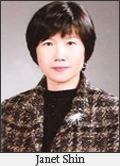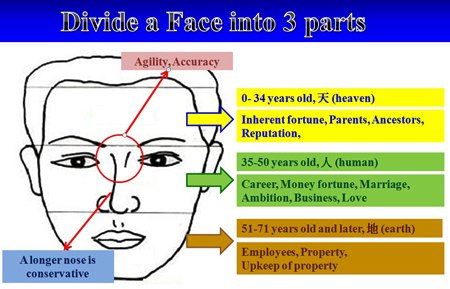Face tells one’s aptitude
There are various ways to analyze physical fitness by scrutinizing the musculoskeletal system, body strength, flexibility and so on. Some say it can also be read by faces, one of the Oriental ways of fortune telling. We may find some interesting clues just by reviewing basic theories. One of the rudiments is to divide one’s face into three parts.
The first part is from the upper forehead to eyebrows, which tells one’s inborn fortune or reputation and intelligence. (0-34 years old)
The second is the eyes, nose and cheekbones. These parts tell one’s ambition, health, power and love life during the major years of adulthood. (35-50)
The third includes the mouth and a chin. These represent the latter years to tell how one manages people and assets. (51 and older)
These three parts are symbolized as heaven, human and earth, in that order. Because the first part suggests a given destiny from heaven, the second is constructed by human activity and efforts and the third, portrayed by how people handle their property, which is mostly represented by earth from ancient perception.
The first area usually tells the life of politicians or leaders, especially spiritual ones, because their qualities were assumed to be given by heaven. The second reveals vigorous lifestyles of one’s middle age. This is when most people strive for what they want, either achieving their goals or experiencing failure. Lastly, the third part shows how people lead large groups and run organizations after exploiting their middle age activities.
If this basic face reading theory is appropriately applied, it is uncomplicated to read overall lifestyle and professions. The forehead tells of one’s innate authority and eyebrows, interpersonal skills. Sometimes the shape of the chin can also be gauged to see how they dominate and command an organization.
The second part, or the sphere of humans, mostly tells of one’s efforts to attain life goals, whether it is wealth or other aspirations.
If you look at heads of athletes attending major sporting events, you will see most of them have a protruding middle part of their face. Those who are strong in physical events, such as judo, wrestling and boxing usually have prominent cheekbones. The same applies to their noses unless they have been crushed by heavy blows. Long noses suggest conservativeness and thoughtfulness while quickness and reactivity are rather portrayed by short ones. Meanwhile accuracy can be read by whether one has narrow or wide areas between the eyebrows. When the eyebrows and eyes are close together, people are inclined to pursue more precision, while a bigger gap shows more unconstrained lives and creativity. Most footballers, shooters and archers have their eyes set very close together.
This changes a little when a player becomes a coach or manager. It is partly because of alterations in their lifestyles or with advancing years. But it is more because of the face structures they were born with as they show certain aspects to become a coach, such as a longer nose, a comparatively well-developed forehead and strong chin.
Despite of all these visible features, there are more important factors to determine how and what people achieve for their yearnings. Mental strength, competitive spirit, determination and most importantly, hours and hours of practice are the key factors, which are shown in the eyes, gestures and tones of voice.
There can be differences between what you can do well and what you like to do. It would be more effective if you knew what you could do well if you really want to achieve what you aspire to.
Information: Are you interested in learning more about the ancient Chinese teaching about the “Four Pillars of Destiny?” For further information, visit Janet’s website at www.fourpillarskorea.com, contact her at 010-5414-7461 or email janetshin@hotmail.com.
The writer is the president of the Heavenly Garden, a saju research center in Korea, and the author of “Learning Four Pillars.” <The Korea Times/Janet Shin>



























































